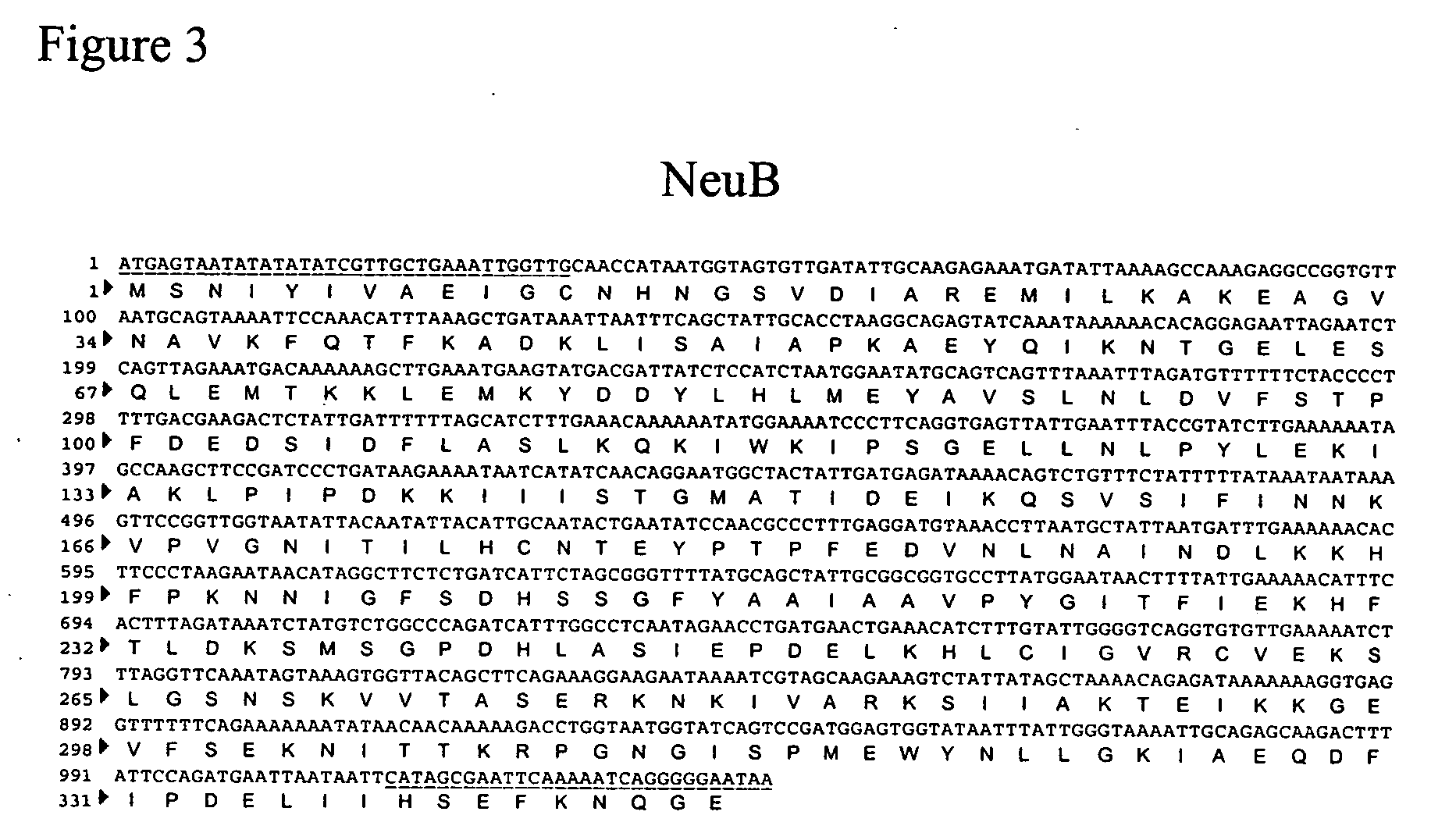Method of engineering a cytidine monophosphate-sialic acid synthetic pathway in fungi and yeast
- Summary
- Abstract
- Description
- Claims
- Application Information
AI Technical Summary
Benefits of technology
Problems solved by technology
Method used
Image
Examples
example 1
Cloning Enzymes Involved in CMP-Sialic Acid Synthesis
[0171] One method for cloning a CMP-sialic acid biosynthetic pathway into a fungal host cell involves amplifying the E. coli NeuA, NeuB and NeuC genes from E. coli genomic DNA using the polymerase chain reaction in conjunction with primer pairs specific for each open reading frame (ORF) (Table 1, below and FIGS. 4, 3 and 2, respectively).
[0172] For cloning a mammalian CMP-sialic acid biosynthetic pathway, the mouse CMP-Sia synthase ORF (FIG. 5) was amplified from a mouse pituitary cDNA library in conjunction with the primer pairs set forth in Table 1. The GlcNAc epimerase (previously discussed in an alternate method for producing CMP-Sia intermediates), was amplified from porcine cDNA using PCR in conjunction with primer pairs specific for the corresponding gene (Table 1 and FIG. 7). The sialate aldolase gene (FIG. 9) was amplified from E. coli genomic DNA using the polymerase chain reaction in conjunction with the primer pairs...
example 2
Expression of Bacterial Neu Genes In P. pastoris
[0173] The 1176 bp PCR amplified fragment of the NeuC gene was ligated into the NotI-AscI site in the yeast integration vector pJN348 (a modified pUC19 vector comprising a GAPDH promoter, a NotI AscI PacI restriction site cassette, CycII transcriptional terminator, URA3 as a positive selection marker) producing pSH256. Similarly, the PCR amplified fragment (1041 bp) of the NeuB gene was ligated into the NotI-PacI site in the yeast integration vector pJN335 under a GAPDH promoter using ADE as a positive selection marker producing pSH255. The 1260 bp PCR amplified fragment of the NeuA gene was ligated into the NotI-PacI site in the yeast integration vector pJN346 under a GAPDH promoter with ARG as a positive selection marker to produce pSH254. After transforming P. pastoris with each vector by electroporation, the cells were plated onto the corresponding drop-out agar plates to facilitate positive selection of the newly introduced vect...
example 3
Expression of GlcNAc Epimerase Gene In P. pastoris
[0174] The PCR amplified fragment of the porcine GlcNAc epimerase gene was ligated into the NotI-PacI site in the yeast integration vector pJN348 under the control of the GAPDH promoter, using URA3 as a positive selection marker. The P. pastoris strain producing endogenous GlcNAc was transformed with the vector carrying the GlcNAc epimerase gene fragment and screened for transformants.
PUM
| Property | Measurement | Unit |
|---|---|---|
| Enzyme activity | aaaaa | aaaaa |
Abstract
Description
Claims
Application Information
 Login to View More
Login to View More - R&D
- Intellectual Property
- Life Sciences
- Materials
- Tech Scout
- Unparalleled Data Quality
- Higher Quality Content
- 60% Fewer Hallucinations
Browse by: Latest US Patents, China's latest patents, Technical Efficacy Thesaurus, Application Domain, Technology Topic, Popular Technical Reports.
© 2025 PatSnap. All rights reserved.Legal|Privacy policy|Modern Slavery Act Transparency Statement|Sitemap|About US| Contact US: help@patsnap.com



